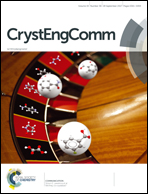Study of the complex formation between the [Cu(bpca)]+ secondary building unit and the aromatic N donors 2,3,5,6-tetra(2-pyridyl)pyrazine (tppz) and 1,3-bis(4-pyridyl)propane (bpp)†
Abstract
Two new complexes of the formula [{Cu(bpca)}2(μ-tppz)](NO3)2·5H2O (1) and [Cu(bpca)(H2O)(ClO4)(μ-bpp)Cu(bpca)(H2O)2]ClO4·H2O (2) [tppz = 2,3,5,6-tetra(2-pyridyl)pyrazine and bpp = 1,3-bis(4-pyridyl)propane] have been prepared by the reaction of the [Cu(bpca)]+ [Hbpca = bis(2-pyridylcarbonyl)imide] building block and the tppz and bpp N donors. An unusual coordination mode of the tppz ligand was observed in 1, which functions as a bis(bidentate) ligand to two copper(II) atoms each coordinated to a nitrogen atom of the pyrazine moiety and a pyridyl nitrogen atom. This compound presents a layered structure of alternating anionic (ca. 1.6 Å) and cationic (ca. 10 Å) slices, providing the opportunity to obtain isomorphic structures by exchanging the counterion, the solvent or both of them. As in 1, each bpca group in 2 is the end-cap ligand being coordinated to the copper(II) ion through its three nitrogen atoms in equatorial positions. The supramolecular layers in 2 are filled by the disordered water molecules and one of the perchlorate groups where the volume occupied by the disordered water can be considered as a void of 91.9 Å3. Additionally, the very weak antiferromagnetic couplings observed in 1 [J = −0.16] and 2 [J = −0.41 cm−1] can be understood by simple orbital symmetry considerations about the type and orientation of the magnetic orbital at each copper(II) ion in both compounds which provide a clear picture of the poor ability of the involved bridges in mediating electronic effects between the paramagnetic centers.
![Graphical abstract: Study of the complex formation between the [Cu(bpca)]+ secondary building unit and the aromatic N donors 2,3,5,6-tetra(2-pyridyl)pyrazine (tppz) and 1,3-bis(4-pyridyl)propane (bpp)](/en/Image/Get?imageInfo.ImageType=GA&imageInfo.ImageIdentifier.ManuscriptID=C7CE01230F&imageInfo.ImageIdentifier.Year=2017)


 Please wait while we load your content...
Please wait while we load your content...